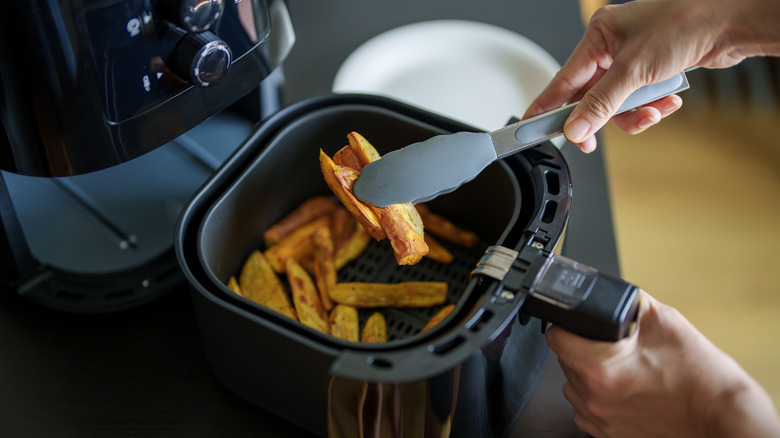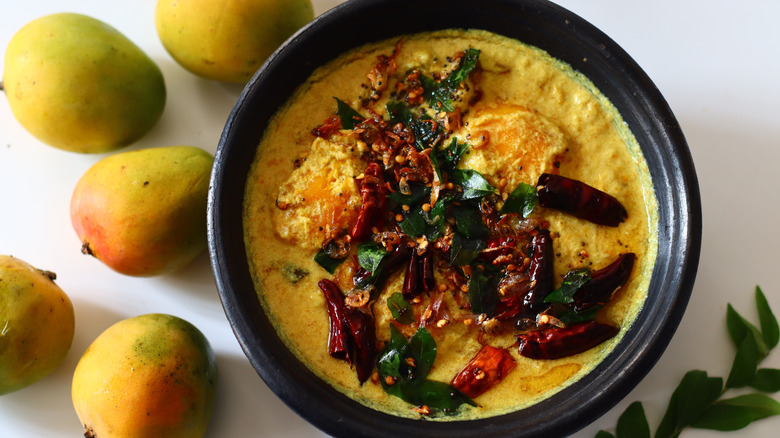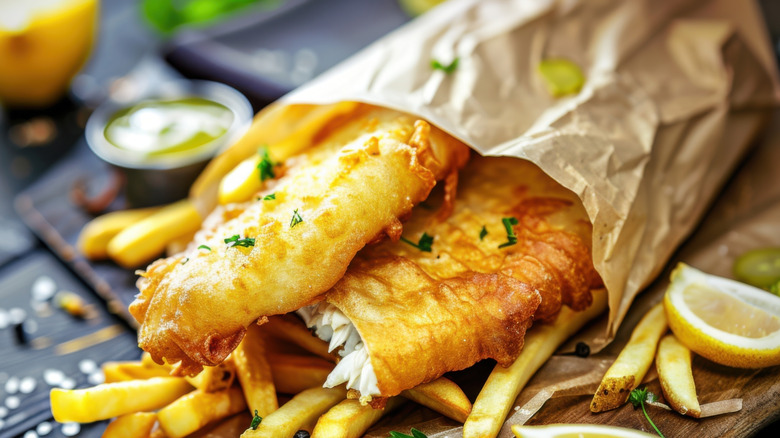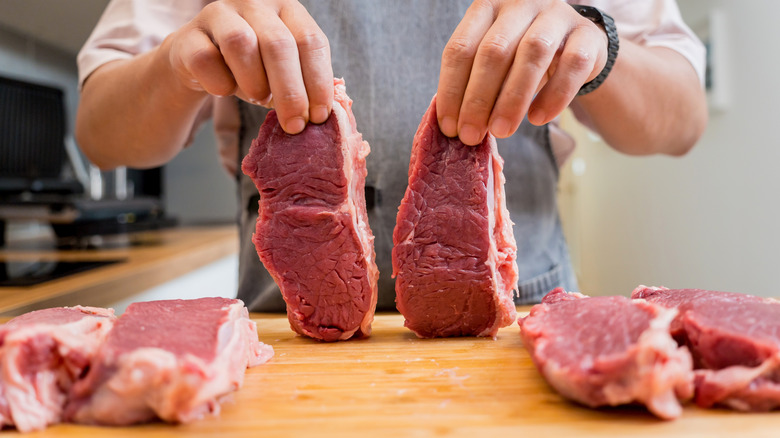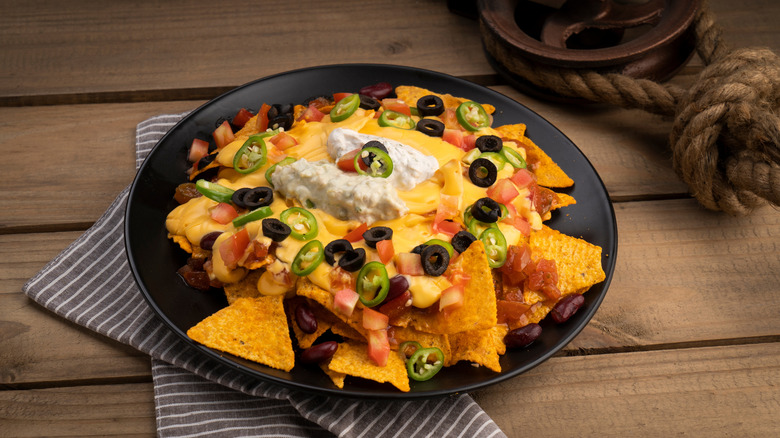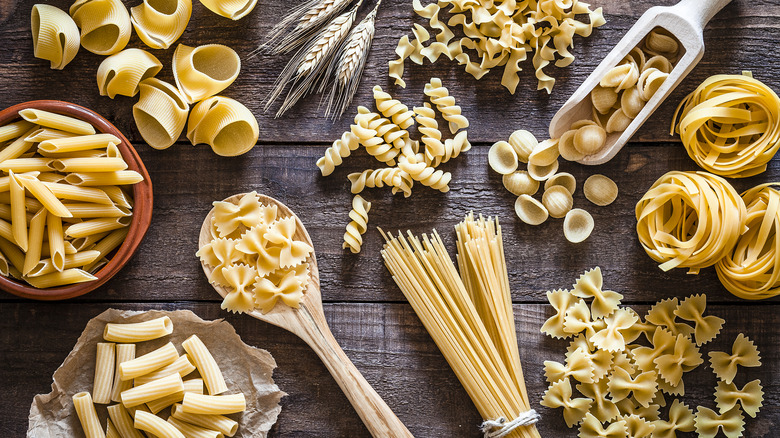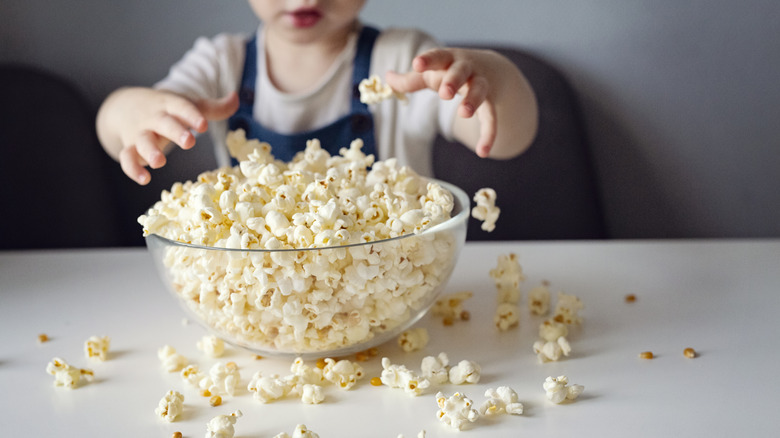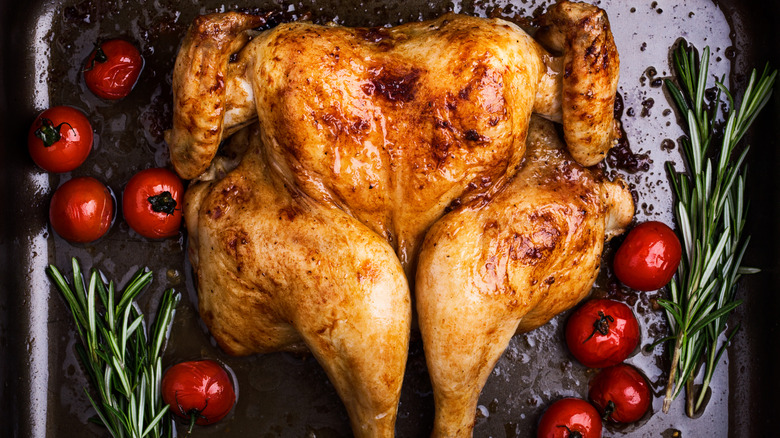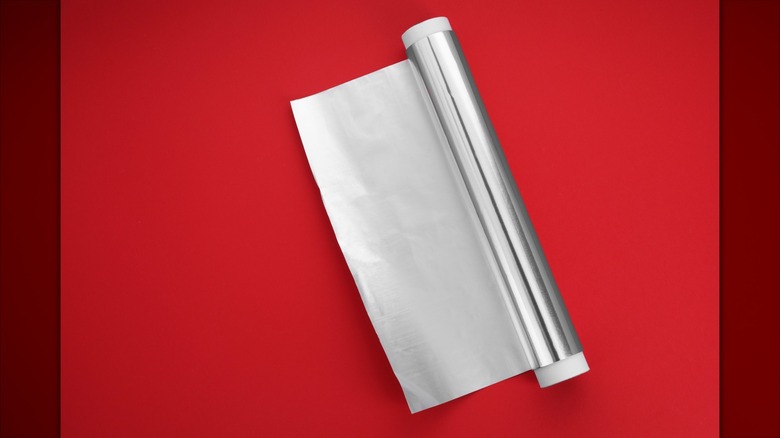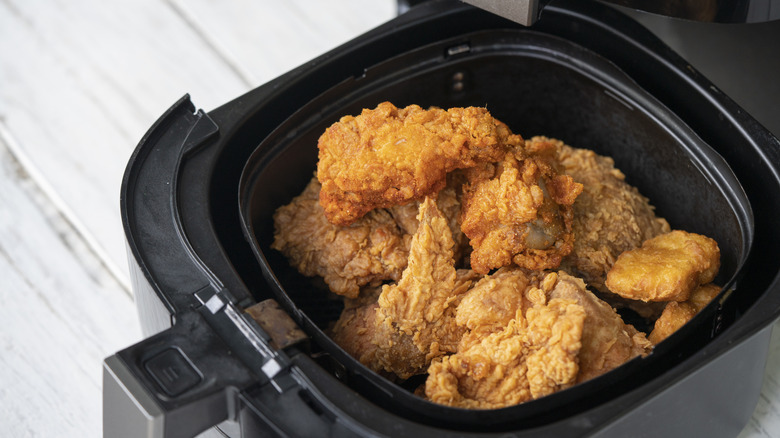12 Things You Should Never Put In An Air Fryer
Even though convection cooking, where hot air is used to prepare food, has been around for a while, air fryers are a relatively recent invention. The first air fryer was released on the market by Philips Electronics in 2010, along with the bold claim that it cooked foods with up to 80% less fat than traditional frying methods. It wasn't long before air fryers became a kitchen staple, gaining popularity in step with the trend of healthy eating.
Aside from requiring little to no oil, air fryers are compact, fast, and user-friendly. They are also extremely versatile, making them suitable for preparing everything from french fries and chicken wings to roasted veggies. That said, not every food can be air fried. Some types of recipes just don't fare well in the fast-circulating air environment of an air fryer. Whether too lightweight, too big, or too moist, cooking certain foods in an air fryer can lead to lackluster meals and a sticky mess, or even damage the appliance.
Ready to find out what is off-limits for your air fryer? Check out our list of the things you should keep away from this modern-day appliance!
1. Sauce-based recipes
Curries and stews are some of the worst dishes to cook in an air fryer. Whether it's a hearty beef stew or a spicy Thai curry, preparing a sauce-based dish in the air fryer is likely to leave you with a huge mess. Air fryers cook by circulating hot air around the food — a method of cooking that can cause liquids to splatter. This isn't just a pain to clean, but it can be dangerous, as you could end up with a nasty burn when trying to retrieve your meal.
There is a much better way of preparing sauce-based dishes than placing them in an air fryer — and that's in a slow cooker. Not only does this help avoid spills and accidents, but stews often require slow cooking to meld flavors together and tenderize meat. Another alternative is heating up the sauce separately from the rest of the meal and pouring it over the finished dish just before serving.
2. Liquid-based dishes like soups and broths
Liquids and air fryers simply don't mix. Air fryers are not designed to cook liquidy foods — be it oil, water, or any other type of liquid-based dish like soup. Since the gadget operates by rapidly circulating hot air around the appliance, placing any liquid inside creates a safety hazard. This doesn't just risk a nasty burn, but the hot liquid can also splatter on the unit's electrical components or heating elements, potentially breaking it.
While it may not be the best way to cook liquid-heavy dishes, it's possible to make a soup in an air fryer — all you need is a little creativity. One method is to caramelize the vegetables for the soup in the air fryer and then add them to the pot of broth. For best results, roast veggies like butternut squash, pumpkin, and red pepper in an air fryer for around 20 minutes before blending them with the broth and some heavy cream. While you can finish preparing the dish on the stove, you can also place all your ingredients — including the broth — in a heat-safe bowl and warm them up in an air fryer. To add texture to the soup, simply air fry some bread to turn it into croutons or bread dippers.
3. Food coated in wet batter
Many people consider air fryers to be a healthier choice than deep frying, as they require less oil to achieve similar results. That said, certain foods that would normally taste amazing deep fried just don't hit the mark in the air fryer. Wet batters, for instance, typically create a mess rather than a crisp coating.
Whether it's battered fish fillets and calamari rings or juicy chicken tenders, these popular comfort foods should be kept well away from an air fryer unless you are ready to peel sticky batter off the fryer basket. Air fryers are simply not designed to handle wet batter. Rather than setting, the batter coating will slide off the food, pooling at the bottom of the basket. The issue lies with the little amounts of oil used to air fry food — it's the large amount of oil in a deep fryer that keeps the wet batter in place.
If you absolutely have to prepare battered items in an air fryer, it's best to coat them in a semi-wet batter — after all, it's the liquid that's your enemy here. One way of doing this is to replace buttermilk with egg and pair it with dry coatings like breadcrumbs and flour. In addition, it's a good idea to place the battered food in the refrigerator — or even freeze it — to firm it up before air frying.
4. Steak
From filet mignon and sirloin to T-bones and rib-eyes, steaks truly shine when cooked with a good sear or char. In fact, the key to making a mouthwatering steak lies in a blazing-hot cast iron skillet. High heat triggers the Maillard reaction, a process that both browns the meat and gives it its rich umami flavor. All this is something that an air fryer just can't deliver.
Air fryers only reach around 450 degrees Fahrenheit, which is comparably low to what can be achieved on a stovetop, limiting their ability to create a proper sear. In addition, the circulating air of an air fryer can dry out the meat instead of keeping it nice and juicy. Perhaps one Reddit user sums this up best, saying, "An air fryer just doesn't give the same well developed flavor, as most of them can't get hot enough. It just tastes like cooked beef, no flavor from the char/crust. Cast iron or heavy stainless [pans are] the way." Another downside to preparing a steak in an air fryer is that you can't infuse the meat with flavor by basting it in butter and aromatics as it cooks.
While an air fried steak will never live up to the flavor and texture of a stovetop-cooked cut, preparing a steak in an air fryer is possible. The best way to do this is to use the reverse-sear approach, where the steak is cooked in an air fryer at 250 degrees Fahrenheit until it reaches the internal temperature of 95 degrees Fahrenheit. Next, the cut is seared on a hot skillet to develop a crust.
5. Cheesy items
There is a lot to be said for the humble cheese sandwich. It's warm and deliciously gooey and requires minimal ingredients and time. Unfortunately, making the classic snack in your air fryer isn't as straightforward as it may seem. Cheese — and especially grated cheese — doesn't hold well in an air fryer. Firstly, cheese is relatively light, so it's more than likely that it will end up flying around the basket, making a mess or even clogging the heating element — neither a welcome proposition. That said, some cheese types with higher melting points like feta, Halloumi, and ricotta hold their shape relatively well in the air fryer.
Whether it's a cheese sandwich or a loaded nacho plate, there is a way to melt cheese in the air fryer without making a complete mess (well, sort of), and that's by mixing it with a little butter or mayonnaise to weigh it down. In addition, to keep cheese slices in place, you can try pinning them down with a toothpick. To err on the side of caution, always line the air fryer basket with baking paper or an air fryer liner to contain any cheese leaks.
6. Uncooked pasta and rice
Dry kitchen staples like pasta and rice require boiling or simmering in water to soften. This simply isn't possible to do in an air fryer, as the appliance cooks by circulating dry heat. Placing water in an air fryer is almost guaranteed to result in splatters, posing a safety risk and even damaging the appliance. It's also likely to leave your food rock-hard or burnt, as explained by one Reddit user: "Dry pasta in the air fryer would lead to ... toasted dry pasta. Which is a nice snack if you like making your gums bleed, I guess?"
While it's still preferable to cook pasta on a stovetop, making it in an air fryer isn't completely out of the question. To recreate a boiling environment in an air fryer, place water and dry food in an air fryer-safe dish and cover it with foil. This will ensure that the water doesn't splash around inside the appliance. To prevent the pasta from becoming overly crispy, it's essential to set the air fryer at a low temperature — as a rule of thumb, this should be around 180 degrees Fahrenheit.
While cooking pasta or rice inside an air fryer isn't recommended, the appliance can be used to reheat previously cooked dishes. To reheat rice, spread it across the basket to ensure even heating and prevent clumping. When it comes to cooked pasta, a light coating of oil can go a long way to stop it from drying out in an air fryer.
7. Toast
While you can replace your toaster with a broiler, the same can't be said for an air fryer. There are multiple reasons for this. Air fryers cook by circulating hot air, which removes moisture from the food. There is no doubt that this cooking method is effective for many dishes and snacks — however, toasted bread is not one of them. The lack of direct heat will leave the bread slices dry rather than crispy and browned. In addition, since the heat in an air fryer radiates from the top, the bread will only crisp up on one side unless you flip it halfway through the cooking cycle.
Just like with most things in the kitchen, there is always a workaround if you're willing to get a little creative — toasting bread in the air fryer is no exception. For best results, it's best to choose a dense bread like sourdough, rye, or multigrain and cut it into thick slices to ensure that it doesn't dry out too much. Lay the slices flat in the basket and turn them after a few minutes to achieve even browning on both sides.
8. Popcorn
Making fluffy popcorn in a microwave is a piece of cake. Just toss in a prepackaged microwave popcorn bag, press the timer button, and wait a minute or two. Once the kernels have stopped popping, carefully remove the bag from the appliance, pour the puffy snack into a bowl, and infuse it with flavor. Go the classic route with a drizzle of melted butter or think outside the box and try our creative recipe for citrus popcorn.
Unfortunately, this simple popcorn-making method can't be replicated in an air fryer. And the reason for this is simple — many air fryers don't get hot enough to pop corn. Kernels start to pop at between 400 and 460 degrees Fahrenheit, while most air fryers can't reach temperatures above 400 degrees Fahrenheit.
Even if an air fryer manages to pop a few kernels, there is another very serious issue that should stop you from choosing it over the microwave. Some air fryer baskets have grates wide enough for unpopped kernels to slip through, which means that they are likely to end up in the heating element, damaging the appliance or even starting a fire. One Redditor explains this, saying, "The air fryer isn't closed inside. The fan and vents are directly above the basket, which allows the air to circulate. That also means it's really easy to blow small or lightweight foods — you know, like popcorn kernels — all over the place. When that happens, popcorn kernels can easily become lodged inside the heating element, causing your air fryer to short (and creating a fire hazard)."
9. Large, bone-in cuts of meat or whole poultry
Whether it's a juicy chicken, a pork crown roast, or a bone-in beef rib roast, these hefty meat and poultry classics are best prepared in the oven. Not only are ovens large enough to accommodate them, they also provide uniform heat that ensures thorough cooking.
Even if you manage to squeeze an entire chicken into your air fryer, the lack of space would probably prevent hot air from circulating properly around the poultry, leaving it unevenly cooked. What's more, the bones in the poultry — or meat, for that matter — act like insulators, slowing down the cooking process even more. Since uncooked chicken can lead to foodborne illness, ensuring that it is thoroughly cooked isn't just about the quality of your meal but also a food safety issue.
Luckily, there is a very simple solution to this dilemma — just cut the meat or poultry into smaller pieces. For instance, instead of tossing the entire chicken in the appliance, divide it into chicken breasts, wings, and thighs. This will let the hot air circulate around the poultry, ensuring that it's evenly cooked while keeping any foodborne risks at bay.
10. Leafy greens
If you think that air frying leafy greens will turn them into crispy chips, you aren't wrong — well, not exactly. It all depends on what vegetables you decide to air fry and how you do it. Most leafy greens are too lightweight to stay in place in the air fryer. Lettuce, Swiss chard, and spinach leaves are just some examples of fragile greens that are likely to end up flying around in the air fryer basket. The likely result? Soggy or burnt greens with very little crunch.
Home chefs determined to turn veggies into crispy chips in an air fryer should stick to sturdier leaves like kale. The key to success is weighing the greens down so they stay anchored during the cooking process. One of the best ways to do this is to coat them in olive oil or cooking spray. Alternatively, you can keep the leaves in place by pinning them down with an air fryer rack. Once the leaves are spread out in a single layer at the bottom of the air fryer basket, set the appliance to 375 degrees Fahrenheit and fry them for four or five minutes. Don't forget to shake the basket halfway through the cooking process to ensure that the leaves crisp up on all sides.
11. Loose aluminum foil or parchment paper without food to weigh it down
Just like other kitchen appliances, air fryers can get messy because the hot air that circulates around the gadget can cause food to splatter inside the basket. The good news is that you can easily catch any drips and grease with protective kitchen liners like aluminum foil or parchment paper (not to be confused with wax paper). Alternatively, opt for special air fryer liners made from paper or silicone. The trick is to stop the liners from flopping around inside the appliance. Thankfully, this is pretty easy to do — simply weigh them down with food.
An out-of-control liner inside an air fryer can spell trouble for a couple of reasons. To begin with, it could fly up to the heating element. If it gets stuck in the wrong spot, it could damage the air fryer, leading to costly repairs. In addition, lining the bottom of the cooking basket with aluminum foil or parchment paper could block the slats that allow the air in the air fryer to circulate. To avoid this, trim the liner so it doesn't cover the entire bottom surface of the air fryer. Last but definitely not least, never use aluminum foil when cooking acidic foods like tomatoes, as the two can react chemically, potentially leaching aluminum into the food.
12. Too much food at once
While it may be tempting to get your meal prep done in one go, overloading the air fryer is a sure way of ending up with unevenly cooked food. Cramming too much food in the basket affects the way the air circulates around the cooking chamber. If the items are too close together, the hot air won't be able to reach all of the surfaces, leaving some areas overdone and others raw. Overfilling the basked can also lead to steaming, which usually translates to soggy, rather than crispy, food.
To ensure that the food cooks evenly and crisps up, don't fill the air fryer basket more than halfway. This will not only allow the air to circulate freely around the food, but also make it easier to reposition it when it's time to shake the basket. If you are preparing a meal for a large group, it's best to cook the food in batches rather than risk subpar results.
